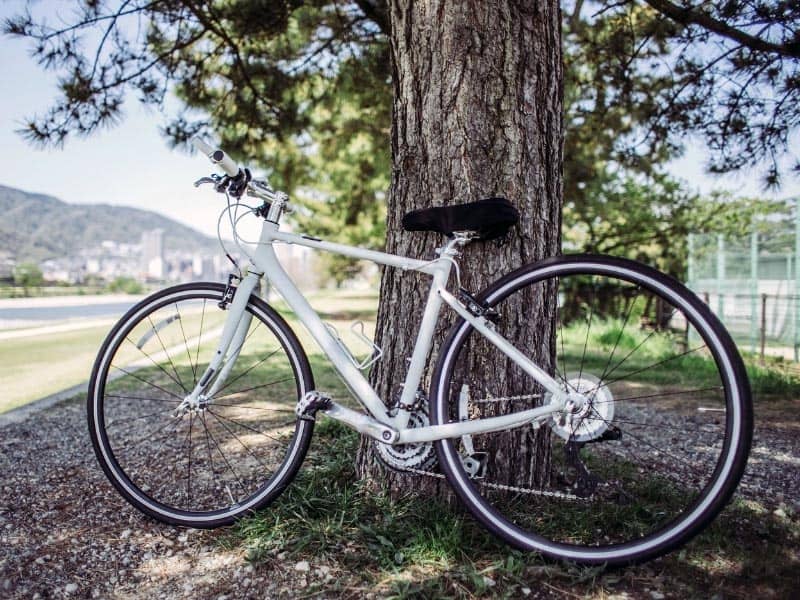Any cyclist knows that a bicycle cannot stand on its own, so why do some bikes not have kickstands? As it turns out, there are several reasons why and I have the answers right here for you.
Mountain bikes and street bikes do not typically have a kickstand anymore. There are a few reasons why this change occurred including weight, balance issues and safety. As bicycles have evolved, there is less need for the kickstand. Now, this is only a feature you see on some leisure bicycles.
There was a time when bikes always came with a kickstand. That little piece of metal that helps prop the bike up when it is stationary.
This can leave you wondering how you are going to store your bicycle if there is no kickstand.
There are alternatives to storing your bike without a kickstand and they are more effective in keeping your bike off the ground.
I found several reasons why your bike will be just fine without a kickstand and can recommend better ways to store your bike.
Recommended Gear
To see all of my up-to-date recommendations for bikes and cycling gear, check out this resource that I made for you!
Table of Contents
Does A Bike Need A Kickstand
Physics shows us that a bicycle cannot stand on its own. So, the kickstand was developed to add the stability needed.
In theory this seemed like a good idea and kickstands do hold a bike up to an extent.
They are not as strong as you may think and often a bicycle can still fall over. There are good reasons why a bike may not have a kickstand.
Benefits of Not Having A Kickstand
The kickstand was developed to help keep your bike upright when you are not riding it.
Just how effective is it though?
The answer depends on several factors like the bike style, the ground, and the environment.
The kickstands are not significant in weight, so really only act as a subtle support system.
Inconsistencies in surface and changes in weather will easily result in the bike falling over. Even in the presence of a kickstand.
Among cyclists, I discovered that it is actually a preference to not have a kickstand and there are several benefits to its absence.
- Bicycles are lighter without a kickstand. While they do not always weigh a lot, the extra metal and position to one side changes the balance of a bike. Even if subtle, this will affect the bike dynamics. If you are looking for a fast bike or one to perform tricks on, a bike without a kickstand is a better option.
- If you have pegs for towing, they are usually positioned at either side of the back tires. This is also the standard placement for a kickstand. Not having a kickstand means nothing can get in the way of you towing another person.
- Your foot or clothing can’t get caught in the kickstand if it is not there. This is a hazard for cyclists, but it can also damage the bike. If you are cycling and your foot or something gets caught on the stand, you can lose balance, fall, hurting yourself and damaging the bike in the process.
- Anyone who has had a kickstand knows that they can get stuck sometimes. It can require some force to kick it loose when you are ready to ride. Kicking it too hard to lift it up can damage the frame of your bike, so better to not have it at all.
- Kickstands can rattle and make noise as you ride along. This is especially true for riding on bumpy roads. It is not only annoying, but it can make you think a critical component of the bike is damaged causing you to stop your ride.
- If the kickstand is located near or on the same side as the gears and chains, it can get caught in them. It can crush the chain if it folds up incorrectly or brush against it during a ride, which damages the chain.
- A kickstand can also get caught in weeds or vines as you ride along. Weeds tangled in the chains can be a mess and can cause injury or damage to the bike.
- One of the simplest benefits of not having a kickstand is that they just do not look cool.
Drawbacks To Not Having A Kickstand
Since the kickstand was developed for the purpose of supporting the bike when standing, there are also a few disadvantages to not having one.
- Not having a kickstand makes it more challenging for beginners to balance. Riding a bike requires balance and momentum to keep the bike upright. When you are first getting started this is a learning process. Many beginners find that a kickstand helps during this. Once it has helped you, you may find that you want it removed because it starts to get in the way.
- Without a kickstand, the bike will be laid down more often and this leads to a dirtier bike. When it comes to kids and mountain bikes, dirt is never an issue, but for more expensive leisure bikes, you always being on the ground may be a problem.
- In addition to getting dirty, a bike without a kickstand may get more scratches, especially when dropped. The only way to avoid this is by leaning the bike against something whenever it is not in use.
- Sometimes there may not be anything to lean the bike against, in which case when you don’t have a kickstand, you are left leaving it on the ground.
- You will need to get a rack and hanging hooks for your bike. This is the only way to safely store a bike without a kickstand.
In spite of these disadvantages, there are more benefits to not having a kickstand. So, the verdict is that they are not really necessary.
Which Bicycles Don’t Have Kickstands
Typically, you will find that mountain bikes and road bikes do not have kickstands.
The bulkiness of the kickstand interferes with the frames of these bikes and many cyclists feel they get in the way.
My research confirmed that many popular bicycles on the market do not have kickstands. So, you really do not need one.
Racing bikes like the Canyon Aeroad, are designed for flat surfaces like the street. They are sleek and lightweight. The added weight of a kickstand can throw these bikes off balance.
These bicycles are lightweight to provide extra speed and the lighter weight leaves them more susceptible to being knocked over. Any gust of wind will do it.
During my research I found that cyclists generally agree that a kickstand is not really helpful in this case. They do not weigh much and do not provide enough support to prevent the wind from knocking down a racing bike.
I also found when riding racing bikes with and without kickstands, the kickstand does get in the way. It can easily get caught on things which ruins the dynamics of a racing bike.
Mountain bikes are another style of bike that are commonly found without kickstands. Mountain bikers do not think kickstands are necessary either.
The bikes stand in racks when you are driving to your off-road destination and many have racks at home to hang them when not in use.
While they are out and about, most cyclists lean their bike against a tree or other objects.
Some of the most popular mountain bikes do not have kickstands, proving that they are not necessary.
The Ibis Ripmo V2 XT and the Giant Stance 29 are two of the hottest mountain bikes for 2020 and neither has nor needs a kickstand.
In talking to mountain bike enthusiasts, it was noted that there are reasons kickstands are not needed. The kickstands are light and typically made cheaply. Often, they are just attached anywhere they will fit.
The shape of kickstands makes them perfect for getting caught in your tires which will damage the wheels. Depending on how well they are attached, they can also easily come loose during bumpy rides.
Having the kickstand is not worth the risk of expensive damage to tires or frames.
I also found that most mountain biking experts and enthusiasts will just drop their bikes on the ground when they take a break.
These bikes are built rugged and tough for off-roading, so dirt is just part of its personality. No need to have the extra piece of metal in the way.
Chances are kickstands will not even add stability when the bike is standing on rugged and uneven ground anyway.
Helpful Tips To Know Why Do Some Bikes Not Have Kickstands
Many bikes do not have kickstands, but there are some that still do.
Depending on what you are looking for, I have some helpful tips to keep in mind if you are shopping for a new bike.
- Leisure bikes will usually have kickstands. These are designed for comfort and efficiency and typically have kickstands. These are the bikes you get for family rides and frequent stops to enjoy the scenery. A kickstand is actually helpful in these cases.
- Mountain bikes and racing bikes perform better without kickstands. These bikes have specific designs and kickstands interfere with this can increase the chance of damage to the bike or cyclist.
- Children’s bikes can come with kickstands, but they can interfere with riding as they get caught on things easily. It is best to get a bike with training wheels and then teach your child to lean the bike against something. Let’s be honest, most kids drop their bikes to the ground anyway when something fun catches their attention.
Final Thoughts
If you got a bike or are shopping for one and have noticed that there is not always a kickstand, you may have wondered why.
There are different reasons as to why do some bikes not have kickstands as I have uncovered for you.
Having a kickstand is more of a preference than a necessity, so choose at your discretion. As with everything, there are advantages and disadvantages to a kickstand. You need to decide if it is worth it for you or not.
In my research, it seems as though cycling enthusiasts do not care for kickstands because they are focused on performance and that little piece of metal has nothing to do with that at all.


